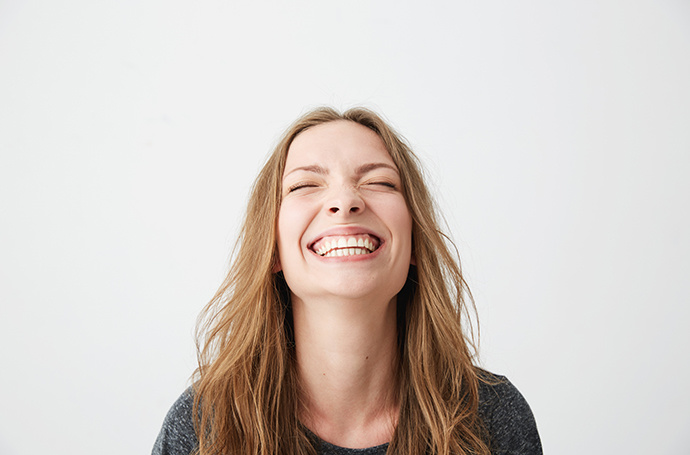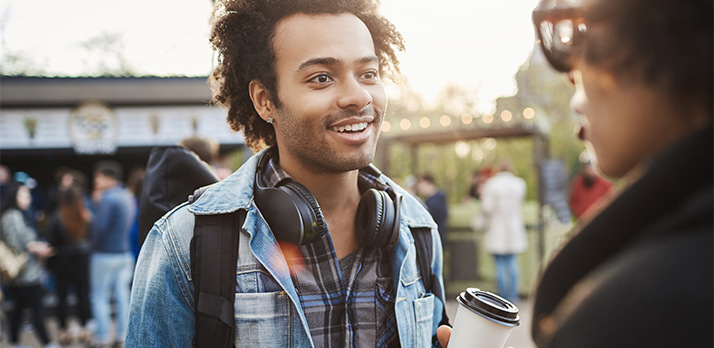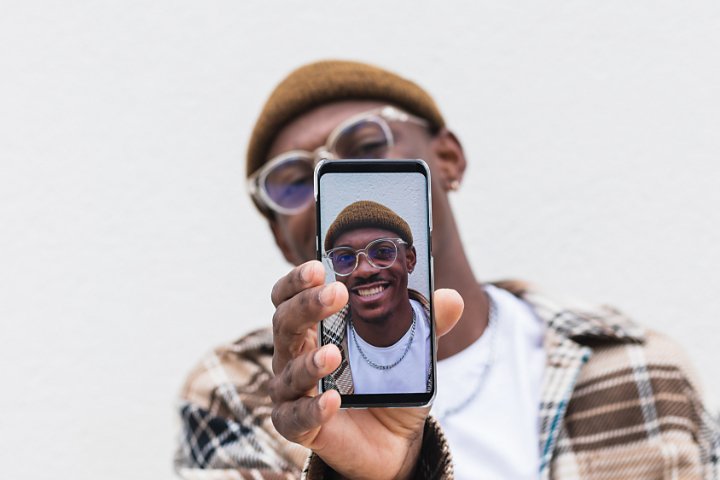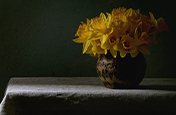Create great portrait photography.
How to catch your subjects in their best light.

You’re more than halfway to great photo portraiture if you can make a genuine connection with your subject.
Anthony Pidgeon, a pro portrait photographer, explains, “So much of a great portrait is about the rapport. That’s not a technical aspect of photography, but I think with portraits it’s really key because you’re collaborating, ideally. Your subject is going to offer you something, and you’re going to honor that and find a way to express it. There’s an element of trust: Do they trust you? Do you trust them to stick with you through the process? Has a rapport been established? Then you can find the best expression of that with lighting and posing and composition.’’
Anna Goellner, who specializes in wedding photography, puts it like this: “You’re trying to tell a story. You’re trying to show who this person is.”
Make a connection.
So how do you go about creating that collaborative moment? Setting up a great photo shoot takes time, so be sure to give yourself a little space. Shawn Ingersoll, a designer and photographer, suggests that when scheduling a shoot, you should allow at least an hour. He explains, “It’ll be maybe the first 30 minutes before you’ve really gotten to know each other.”
Pidgeon notes that every session will be different, so you’ll need to stay alert to your subject — some will be more available than others. “I think it depends on the person — where they’re at, what’s going on, whether they want to be there. A lot of times, they don’t,” he says. “A lot of times, they’ve had five things lined up before you, and they’ve got another five after you, and they’re just watching the clock. Some people will say, ‘Yeah, let’s do something cool.’ And some people will say, ‘Let’s get this over with.’ Some people are really shy. Getting a feel for their level of engagement directs a lot of it.”


When you have a sense of the person you’re working with, then turn your attention to the room. Pidgeon suggests asking yourself, “Are there natural light sources? Is it a situation where I’m going to use harsh lighting, soft lighting, direct, indirect? What's going to tell this story?”
It’s easy to feel rushed when you’re taking someone’s picture, but one of the keys to taking a good portrait is to allow the time to connect and consider. Naba Zabih, a wedding and engagement photographer, says that even in the flurry of a big event, it’s important to take time to compose an image that you’ll be proud of. She continues, “Especially when everything’s digital and super fast-paced, just stop, and compose, and think about the shot before you actually take it.” Keep in mind that with a portrait photo, you’ve got an extra variable to consider: “People are people,” Zabih says, “so they are definitely going to be harder to shoot than something that's still — they’re going to move. They blink. “
Find the right light for your portrait photography.
So many elements of portrait photography rely on intuition over technical control, so it’s useful to be able to identify or arrange great lighting for your portrait session from the start. If you’re shooting in a studio, you’ll get to make a lot of these decisions in advance.
Ingersoll suggests, “If you want a dramatic, high-contrast portrait, you’re probably going to use more direct light, whether that’s sunlight or artificial lights. If you’re looking for a less dramatic photo, more like a professional headshot, that’s going to be more diffused, with multiple light sources. You’ll have a primary one, typically the brightest, and it’s going to light up one side of the subject’s face. Then you’ll want to light up the other side, so you’ll have a secondary stroke — otherwise you’re going to have a very dramatic picture. A third light is optional. Sometimes you use that to light up their hair or the backdrop, if there is one.”
“As people get older, you want to soften up the light a bit, unless you really want to accentuate the texture in someone’s skin.”
Pidgeon advises, “As people get older, you want to soften up the light a bit, unless you really want to accentuate the texture in someone’s skin. But if someone has acne scars or wrinkles, you wouldn’t typically work with a dramatic light, unless this is really part of who they are. I think part of it is asking, ‘Is this going to be kind to them, show them in their best light? Are they a dynamic person? Do they have an edge to them? Is this appropriate?'”
He warns that portrait photographers need to understand how to balance their lights. “A lot of beginners tend to overpower with flash, and then you have that mugshot kind of look,” he says. “You’re basically making two exposures at the same time when you’re balancing the main light and the fill light. When you develop an understanding of how that balance works, you can make incremental changes instead of just saying, ‘OK, I’m going to blast it or I’m going to take it away.’”

If you’re shooting outdoor portrait photography, using mostly natural light, you’ll need a slightly different toolkit. Goellner’s experience with outdoor weddings has taught her that the middle of the day is the worst time to shoot. She explains, “The sun is right overhead, and you’ll have shadows under their eyes. I’m looking for even lighting for portraits. If it’s the middle of the day, which so many times during a wedding it is, you always look for trees.”
It’s all about the eyes.
Goellner holds that one of the most important tips for portrait photography is getting a sharp focus on your subject’s eyes: “If you’re focused on somebody’s forehead or bangs, and their eyes are out of focus, it automatically kills it,” she says, “unless you’re being really artsy.” Beyond this simple but vital reminder, you’ll want to consider the lens you’re working with.
Goellner says that the best lenses for portraiture will open up really wide. “A really wide aperture lets in a lot of light, and lets the background be blurry,” she says. Wide-angle lenses and a shallow depth of field help you to keep the focus on your subject, rather than losing them to background elements that might be less important. Goellner’s go-to portrait lens is an 85mm lens.
Derek Boyd, a photographer in the Pacific Northwest, suggests trying out even longer focal lengths: “If you have a long focal length and you’re close to your subject, you’ll have very shallow depth of field,” he says. “So a 200-millimeter lens is great for portrait work. Basically, you shoot almost as close up as you can with it, and it looks great because the background gets blurred out. And the compression that telephoto lenses cause — it’s a little bit of distortion that’s very flattering to people. It makes noses look a little bit smaller, and it makes eyes look a little bit better. It’s just very complimentary.
“It’s hard to describe,” Boyd continues, “but any time you see a nice tight portrait like a glamour shot, that’s almost always done with the very long focal length. Now, on the other hand, you have your wide focal lengths, so that would be anything 30 millimeters and lower. If you get real close to somebody with a wide-angle lens, it makes their head look really big and everything in the background look really small, and you almost get that fish-eye effect. It is not complimentary. You can use it for portraits, but it looks silly.”



The kicker here is the ability to choose your focal point. Boyd explains, “Before I shot on a real camera, an SLR, I’d only shot on point-and-shoots where everything was in focus. I think that’s the difference between a snapshot and a real artistic photograph — highlighting your subject. That doesn’t mean that you have to use shallow depth of field, but a professional-style portrait will. And the first time that you do it on your own, it’s like magic. That look is something that I’ll always be a sucker for. I’ll always love a portrait with a just completely blurred-out background, and a nice, sharp eye with a catch-light, a nice twinkle in the eye.”
Once you’ve learned the rules, try breaking them.
Many photographers will start out using automated program modes to shoot. Those can be very helpful as you begin, allowing you time to connect with your subject and concentrate on lighting, but Pidgeon warns that they can ultimately hamper your progress.
“A program can give you the basics, but I don’t think you can get very creative,” Pidgeon says. “The program is there to keep you within the range of ‘this will be fine.’ But if you’re getting into photography, you want more than fine. You have to go manual to get that nuance. And that’s scary — a lot of people think, ‘Hey, this particular program mode works great. I got awesome photos in this situation. I don’t want to let go of that.’ And then suddenly you’re in a different situation, and it doesn’t work. The program was doing the work for you, doing all the math for you, and making a lot of decisions. So then you have to go back and figure out how exposure works.” Learning those manual camera settings, and getting access to more nuanced decisions means you can get much more creative, artistic portrait photography.
And there’s no need to stop with refining your use of exposure. Alex Tan, a photographer and designer based in Los Angeles, encourages even more experiments. He says, “I think filling the frame is really interesting: when there’s parts of an image that aren’t necessarily fully in the frame or there’s a subject that’s very much in the foreground and maybe covering a third of the frame. I feel like I’ve transitioned a lot lately from taking portraits of people that were perfectly centered in the frame on really clean backgrounds to ‘What would that look like if the camera was actually in this room and it was behind somebody or looking over somebody’s shoulder?’”

All of this harks back to that foundational element of portrait photography. Tan says, “This is probably a general rule of thumb for a lot of photography: story is king. That’s the reason why we make things, the reason why we design, the reason why we make films, the reason why we write — and I just would really encourage people to not forget that.”
Zabih emphasized this same idea, saying, “Portraiture is interesting because you often kind of throw the rules out the window. If I’m able to capture some kind of emotion in the photo, I feel like it’s huge. I'll do photos where I'm purposely messing up the photo — where I lower my shutter speed or shoot things cropped in a way that I normally wouldn’t. And as long as there’s emotion in the photo, they end up being my favorite. What’s cool about portrait photography is it doesn’t have to be a perfect image to be the best image.”
Find some portrait inspiration.
The world of portraiture is vast and varied. If you’re looking for a good place to start, try exploring a few different portrait styles to see what works best for you.
Self portraits are a creative form of self-expression, but they’re also a great way to perfect your portrait photography skills. When you’re both the model and the photographer, you can take your time while adjusting camera settings, trying different lighting, and experimenting with creative ideas.

Take professional headshots.
With headshot photography, you can bring your creativity into a professional setting. While corporate headshots often need to follow a specific style or visual approach, you can always find unique ways to help individuals stand out and bring personality to their pics.
From fine art portraits to avant-garde fashion shots, glamour photography highlights a subject’s personality, attitude, and appearance. Learn how to plan your own glamour photoshoot, polish your images with post-production editing tools, and then add some glamour shots to your portfolio.
Whether you’re a seasoned pro or new to photography, portraiture is a wonderful way to build skills and foster creativity. Give it a try for yourself, and remember to always keep the focus on your subject and highlight their personality.
Contributors
Do more with Adobe Photoshop Lightroom.
Edit photos easily with Lightroom presets, Super Resolution, easily share photos from any device, and access your projects anywhere with cloud photo storage management.
You might also be interested in…
Understanding shallow depth of field.
Explore how shallow depth of field can add dimension to your photographs.
How to use, and break, the rule of thirds.
Improve your photo composition skills to capture more stunning images.
The art of still life photography
Improve your composition skills by learning the art of still life photography.
Journey to a new world and make small subjects larger than life with macro photography tips.



